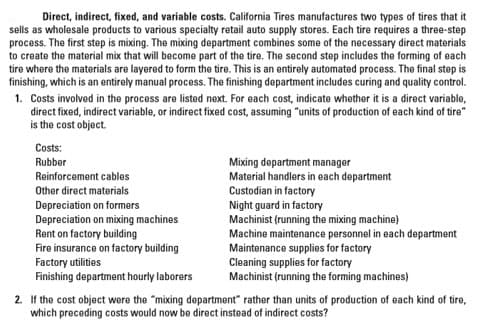Direct, indirect, fixed, and variable costs. California Tires manufactures two types of tires that it sells as wholesale products to various specialty retail auto supply stores. Each tire requires a three-step process. The first step is mixing. The mixing department combines some of the necessary direct materials to create the material mix that will become part of the tire. The second step includes the forming of each tire where the materials are layered to form the tire. This is an entirely automated process. The final step is finishing, which is an entirely manual process. The finishing department includes curing and quality control. 1. Costs involved in the process are listed next. For each cost, indicate whether it is a direct variable, direct fixed, indirect variable, or indirect fixed cost, assuming "units of production of each kind of tire" is the cost object. Costs: Rubber Mixing department manager Material handlers in each department Custodian in factory Night guard in factory Machinist (running the mixing machine) Machine maintenance personnel in each department Reinforcement cables Other direct materials Depreciation on formers Depreciation on mixing machines Rent on factory building Fire insurance on factory building Factory utilities Finishing department hourly laborers Maintenance supplies for factory Cleaning supplies for factory Machinist (running the forming machines) 2. If the cost object were the "mixing department" rather than units of production of each kind of tire, which preceding costs would now be direct instead of indirect costs?
Direct, indirect, fixed, and variable costs. California Tires manufactures two types of tires that it sells as wholesale products to various specialty retail auto supply stores. Each tire requires a three-step process. The first step is mixing. The mixing department combines some of the necessary direct materials to create the material mix that will become part of the tire. The second step includes the forming of each tire where the materials are layered to form the tire. This is an entirely automated process. The final step is finishing, which is an entirely manual process. The finishing department includes curing and quality control. 1. Costs involved in the process are listed next. For each cost, indicate whether it is a direct variable, direct fixed, indirect variable, or indirect fixed cost, assuming "units of production of each kind of tire" is the cost object. Costs: Rubber Mixing department manager Material handlers in each department Custodian in factory Night guard in factory Machinist (running the mixing machine) Machine maintenance personnel in each department Reinforcement cables Other direct materials Depreciation on formers Depreciation on mixing machines Rent on factory building Fire insurance on factory building Factory utilities Finishing department hourly laborers Maintenance supplies for factory Cleaning supplies for factory Machinist (running the forming machines) 2. If the cost object were the "mixing department" rather than units of production of each kind of tire, which preceding costs would now be direct instead of indirect costs?
Cornerstones of Cost Management (Cornerstones Series)
4th Edition
ISBN:9781305970663
Author:Don R. Hansen, Maryanne M. Mowen
Publisher:Don R. Hansen, Maryanne M. Mowen
Chapter6: Process Costing
Section: Chapter Questions
Problem 38P: Healthway uses a process-costing system to compute the unit costs of the minerals that it produces....
Related questions
Question

Transcribed Image Text:Direct, indirect, fixed, and variable costs. California Tires manufactures two types of tires that it
sells as wholesale products to various specialty retail auto supply stores. Each tire requires a three-step
process. The first step is mixing. The mixing department combines some of the necessary direct materials
to create the material mix that will become part of the tire. The second step includes the forming of each
tire where the materials are layered to form the tire. This is an entirely automated process. The final step is
finishing, which is an entirely manual process. The finishing department includes curing and quality control.
1. Costs involved in the process are listed next. For each cost, indicate whether it is a direct variable,
direct fixed, indirect variable, or indirect fixed cost, assuming "units of production of each kind of tire"
is the cost object.
Costs:
Rubber
Mixing department manager
Material handlers in each department
Custodian in factory
Night guard in factory
Machinist (running the mixing machine)
Machine maintenance personnel in each department
Reinforcement cables
Other direct materials
Depreciation on formers
Depreciation on mixing machines
Rent on factory building
Fire insurance on factory building
Factory utilities
Finishing department hourly laborers
Maintenance supplies for factory
Cleaning supplies for factory
Machinist (running the forming machines)
2. If the cost object were the "mixing department" rather than units of production of each kind of tire,
which preceding costs would now be direct instead of indirect costs?
Expert Solution
This question has been solved!
Explore an expertly crafted, step-by-step solution for a thorough understanding of key concepts.
This is a popular solution!
Trending now
This is a popular solution!
Step by step
Solved in 3 steps with 1 images

Recommended textbooks for you

Cornerstones of Cost Management (Cornerstones Ser…
Accounting
ISBN:
9781305970663
Author:
Don R. Hansen, Maryanne M. Mowen
Publisher:
Cengage Learning

Managerial Accounting: The Cornerstone of Busines…
Accounting
ISBN:
9781337115773
Author:
Maryanne M. Mowen, Don R. Hansen, Dan L. Heitger
Publisher:
Cengage Learning

Managerial Accounting
Accounting
ISBN:
9781337912020
Author:
Carl Warren, Ph.d. Cma William B. Tayler
Publisher:
South-Western College Pub

Cornerstones of Cost Management (Cornerstones Ser…
Accounting
ISBN:
9781305970663
Author:
Don R. Hansen, Maryanne M. Mowen
Publisher:
Cengage Learning

Managerial Accounting: The Cornerstone of Busines…
Accounting
ISBN:
9781337115773
Author:
Maryanne M. Mowen, Don R. Hansen, Dan L. Heitger
Publisher:
Cengage Learning

Managerial Accounting
Accounting
ISBN:
9781337912020
Author:
Carl Warren, Ph.d. Cma William B. Tayler
Publisher:
South-Western College Pub

Financial And Managerial Accounting
Accounting
ISBN:
9781337902663
Author:
WARREN, Carl S.
Publisher:
Cengage Learning,

Principles of Accounting Volume 2
Accounting
ISBN:
9781947172609
Author:
OpenStax
Publisher:
OpenStax College